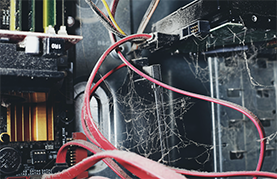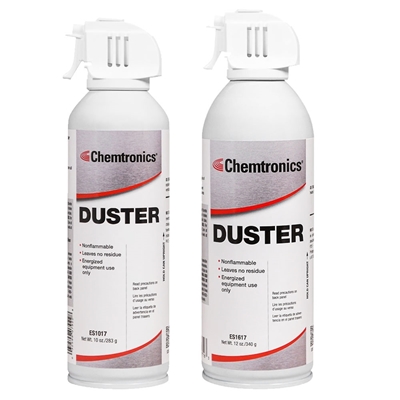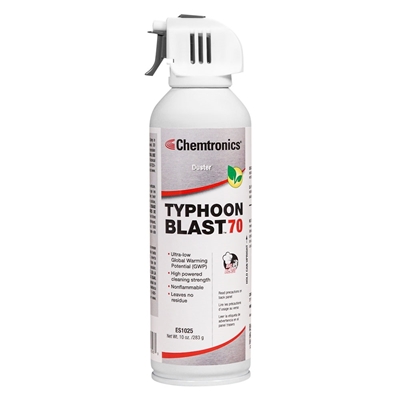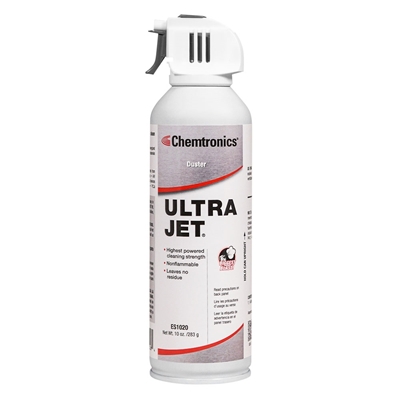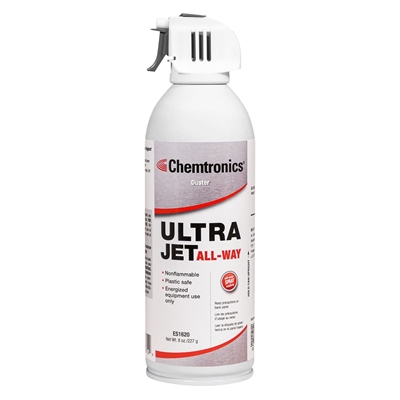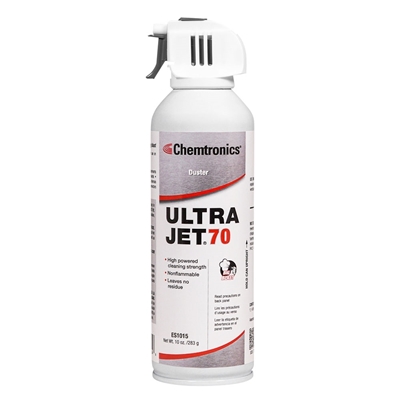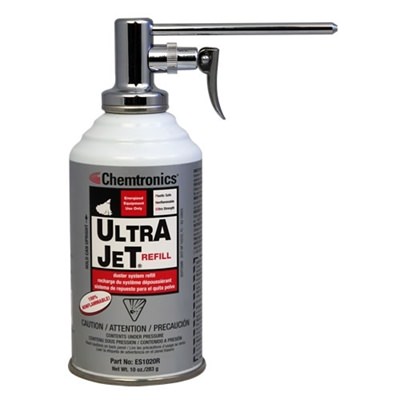Aerosol Duster, which is commonly referred to as “canned air”, “compressed air”, and “dusting gas” is used to dislodge dust and dirt with a pressurized blast. On a production line, it’s not unusual to see compressed air lines dropped for this purpose. While the air is free, compressed air lines are inflexible, so not as useful for small product assembly operations, repair centers, or field repair. That’s where duster shines!
Aerosol duster is used to blast out dust and dirt from keyboards, computer vents, and even in the PCB assembly process by opening up tight stencil apertures. You’ll find duster in just about every facility, but how much do you really know about it? Read on for answers to your frequently asked questions about “canned air”.

What is Inside Aerosol Duster (Canned Air)?
In contrast to the nicknames “canned air” or “compressed air duster”, aerosol dusters contain a refrigerant or propellant that cannot, in any way, be considered breathable air. In fact, you should have proper ventilation when using duster as you would any other aerosol product.
Aerosol dusters contain one of these propellants:
- HFC-134a (1,1,1,2-Tetrafluoroethane, CAS #811-97-2) – This is the same material generally used in modern air conditioning systems. It is nonflammable, making it popular in professional or industrial applications because it can be sprayed on energized circuits. When there is the possibility of sparks or flames (e.g. spraying high voltage electrical devices), HFC-134a is one of the best options. The negative of HFC-134a is its environmental impact. It has a Global Warming Potential (GWP) of 1400, which means it has 1400 times the impact of CO2. On the plus side, it is not considered a VOC (Volatile Organic Compound), so does not contribute to smog.
- HFC-152a (1,1-difluoroethane, CAS #75-37-6) – This material is more common in consumer retail stores because it costs less than HFC-134a. The trade-off is safety since concentrated HFC-152a is flammable, so could light if exposed to an ignition source (e.g. sparks or flame). The risks are highest when spraying in an enclosed area, where vapors could collect, or if turning the can and expelling liquid. HFC-152a dusters have a GWP of 130, so roughly 1/10th of the impact of HFC-134a. HFC-152a is also not considered a VOC, so it can be considered more environmentally “friendly” than HFC-134a.
- HFO-1234ze (trans- 1,3,3,3-Tetrafluoropropene, CAS #29118-24-9) – With the greater focus on global warming, new technology has become available for blowing off dust and dirt. HFO-1234ze is nonflammable and has a very low GWP of less than 1, so below the global warming impact of CO2. This is far below HFC-134a and HFC-152a, and still has the advantage of being VOC-free. So why aren’t we all using HFO-1234ze duster? Because it is newer technology which has not yet been widely adopted by larger volume applications like air conditioning, it is relatively expensive compared to the other alternatives. As usage increases, and regulations force the issue, prices are expected to decrease and this will become more common.
- CO2 (carbon dioxide, CAS #124-38-9) – With carbon dioxide, we are approaching something that could be honestly called “canned air”, although you still can’t breathe it. CO2 is very high pressure, so generally comes in small metal cartridges like those used in air guns. These cartridges plug into a spray system and are replaceable. While CO2 is nonflammable, relatively low GWP, and VOC-free, it has the disadvantages of low capacity cartridges that have to be frequently replaced, and a spray force that isn’t as powerful as the liquid propellant alternatives. In addition, CO2 spray force diminishes as the cartridge runs out, so the first half of the cartridge is more useful than the second half.
- DME (Dimethyl ether, CAS #115-10-6) – DME-based dusters are not as common and in many areas cannot be legally used because of safety and environmental concerns. DME is extremely flammable and is a smog-contributing VOC.
What is The Difference Between Retail/Consumer and Commercial Duster?
Aerosol dusters, or “canned air”, can be purchased from commercial / industrial distributors like Hisco or Grainger, but are also commonly sold through big box stores like Walmart, Home Depot or office supply stores like Office Depot. While the temptation is to buy the lowest cost duster, it is important to be aware of the trade-offs. Low cost dusters available at consumer stores can have a negative impact on worker safety and your product reliability.
- Retail dusters generally contain HFC-152a – If you look at the back of the can of aerosol hairspray, you’ll usually see low-cost propellants like propane (as in your gas grill) or butane (as in a cigarette lighter). For the same price-sensitive reason, HFC-152a is commonly used in dusters available in consumer retail stores. Concentrated HFC-152a is flammable, so could light if exposed to an ignition source (e.g. sparks or flame). The risks are highest when spraying in an enclosed area, where vapors could collect, or if turning the can and expelling liquid. In industrial markets, safety is a top concern with careful oversight by OSHA (for US). This drives industrial users to more commonly spend the extra amount for nonflammable HFC-134a.
- Purity can be questionable – Industrial buyers rely on trusted industrial brands because the quality is closely controlled, especially when the duster is used on critical or sensitive electronics. Material used in commercial dusters are highly filtered, with moisture and other contamination minimized. But there are fewer controls in retail duster.
- Bitterant added to prevent huffing – Retail dusters often contain bitterant to prevent huffing when dusters are accessible to children in the home. The propellant in dusters can be purposely inhaled (called “huffing” or “dusting”) to attain a “buzz”, which can sometimes lead to tragic consequences. To discourage huffing, a bitter agent is added to make the duster taste bad. Of course, these types of risks are not as high in an industrial environment, so concern turns to bitterant as a contamination on sensitive surfaces like electronic circuit boards.
- Fill weight can be deceptive or at least confusing – Don’t be fooled! Retail duster can come in a variety of fill weights (the content of the material in a can) including 3.5 oz., 8 oz., and 10 oz. The can size might be the same, so it is important to check the fill weight on the label. Divide the price by the fill weight, and you’ll get a nice apples-to-apples comparison between products.
e.g.
$5 can cost / 3 oz. fill weight = $1.66 per oz.
$10 can cost / 10 oz. fill weight = $1 per oz.
As you can see, the aerosol can may be the same size, but the number of sprays for the money can vary widely. This method of comparison isn’t as accurate when comparing different propellants, because the basis weight of each is different. In other words, a heavier material may offer fewer sprays per ounce.
Do Aerosol Dusters Hurt the Ozone Layer?
No, this is a misconception based on old information. Dusters contained CFCs (chlorofluorocarbon) over 20 years ago but have since been replaced with materials that do not impact the ozone layer. In North America, there are no commercially available aerosol dusters that contain ozone-depleting propellants.
Are Nonflammable Aerosols Available?
Yes, HFC-134a and HFO-1234ze are two commercially available aerosol dusters, or “canned air”, that are nonflammable. They are popular in professional or industrial applications because of the safety advantages, especially when used on energized circuits. When there is the possibility of sparks or flames (e.g. spraying high voltage electrical devices), HFC-134a and HFO-1234ze are the best options.

Are Higher Velocity Dusters Available for More Aggressive Cleaning?
Each propellant type used in aerosol dusters has potential to produce a specific amount of force. HFC-134a has the greatest potential, HFC-152a next, and HFO-1234ze a distant third. Roughly speaking, the HFC-152a has about 10% less potential to generate force compared to HFC-134a, and the HFO-1234ze has about 33% less potential to generate force compared to HFC-134a.
Chemtronics offers aerosol dusters with even higher spray force by controlling output through the valve and spray head. Ultrajet® Duster generates about 60% more force compared to other HFC-134a dusters. Ultrajet® 70 Duster clocks in at over 40% greater force than standard HFC-134a dusters. These provide an extra boost to push out heavier particles and anywhere more aggressive cleaning is required.

How Can I Spray Aerosol Duster Upside-Down Without Generating Frost?
Because of how the valving of aerosol dusters, or “canned air”, are engineered, they generally can only be sprayed right-side-up or, at most, a 45º angle. Under high pressure, the propellant is mostly liquid, with the empty part of the can filled with vapor. When you spray an aerosol duster, the vapors of the propellant are expelled. As you rotate the can, the liquid starts to spray out and at a very low temperature (as low as -60ºF / -51.5ºC). In some cases, such an extreme temperature swing can damage sensitive components or draw in moisture where you don’t want it.
Chemtronics offers Ultrajet® All-Way Duster, which is specifically designed to spray only gas as you rotate the can. It also sprays with a very high force to dislodge stubborn contamination.

Is There an Aerosol Duster That is Safer for the Environment?
Chemtronics offers Typhoon Blast 70 Duster, which contains HFO-1234ze (trans- 1,3,3,3-Tetrafluoropropene, CAS #29118-24-9). HFO-1234ze is nonflammable and has a very low GWP of less than 1, so below the global warming impact of CO2. This is far below HFC-134a and HFC-152a, and still has the advantage of being VOC-free.
Can You Ground Aerosol Duster for Cleaning Sensitive Electronics?
How Do You Prevent Static When Spraying an Aerosol Duster?
Aerosol dusters predominantly come in a steel can with a plastic trigger sprayer. It is possible for the sprayer to become charged from either handling or from the propellant being discharged, so may be a concern for cleaning sensitive electronics. The Chemtronics Ultrajet® Duster System includes a chrome trigger sprayer and a refill can with a threaded valve. The sprayer can be reused with refill cans that are sold separately. The advantage of the chrome sprayer is more precise spray control and ESD (electrostatic discharge) control. The chrome trigger is conductive, so will not build up a charge, and has the potential of being grounded. For example, if the user is grounded by a wrist strap, the sprayer and can be grounded as well if in good contact with the person’s hand.
What’s The Correct Technique for Spraying Aerosol Duster or “Canned Air”?
To achieve the optimum force out of a can of duster, spray short three- to five-second blasts at room temperature. When an aerosol duster is sprayed continually, it acts as an efficient heat sink and will cool down. This lowering of the can temperature also lowers the internal pressure of the can, which will greatly decrease the generated force.
For more information on finding the best aerosol duster for your application, contact Chemtronics at [email protected] or 770-424-4888.

